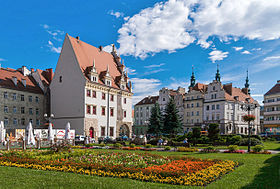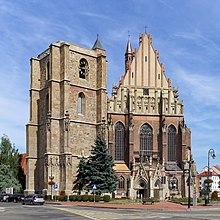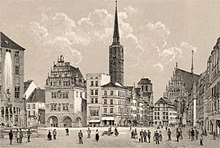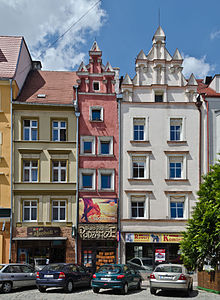Nysa, Poland
Nysa | ||
|---|---|---|
 Main Square | ||
|
Car plates ONY | | |
| Website | http://www.nysa.pl | |
Nysa [ˈnɨsa] ⓘ (German: Neisse or Neiße, Silesian: Nysa) is a city in southwestern Poland on the Eastern Neisse (Polish: Nysa Kłodzka) river, situated in the Opole Voivodeship. With 43,849 inhabitants (2019), it is the capital of Nysa County. It comprises the urban portion of the surrounding Gmina Nysa. Historically the city was part of Upper Silesia.
History

Nysa, one of the oldest towns in

The town's fortifications, dating from 1350, served to defend against the Hussites in 1424. During the Hussite Wars, in 1428 it was the site of the Battle of Nysa, with Poles and Czechs fighting on both sides.[2] One of the prominent signs that Nysa was a significant center is the report in Nuremberg Chronicle, published in 1493, which mentions the city among the major urban centers of Central and Eastern Europe. In the description of the town population included in this chronicle we read "plebs rustica polonici ydeomatis ...". The Nysa coat of arms at the entrance of the Charles Bridge in Prague, which is displayed alongside the arms of the most prominent Bohemian cities, also indicates the importance of the town. In the 16th century it was a Polish printing center.[3]
During the Thirty Years' War (1618–1648) Nysa was besieged three times. It was plundered by the Saxons and Swedes.[2] Polish prince (and later King) Władysław IV Vasa (r. 1632–1648) visited the town several times between 1619 and 1638. In 1624 the Kolegium Carolinum Neisse (today's I Liceum Ogólnokształcące), one of the most renowned schools of Silesia, was established as a Jesuit college.[3] Polish King Michał Korybut Wiśniowiecki[4] and Polish prince James Louis Sobieski both attended this school.

During the
During the
During
During
In the following years, new Polish settlers, some whom were themselves expelled or resettled from what is now Western Ukraine (see: Kresy), made Nysa their new home.
Nysa's monuments

As a result of destruction during
Polish troops were stationed in Nysa until 2001, when they were relocated to Kłodzko.[2]
Economy

Until recently, Nysa was a major industrial centre in the
Recently, the
Sports
- Polish Volleyball League(Polska Liga Siatkówki, PLS), new in 2020 season
- KŻ Nysa – sailing club with seat on Nysa's lake
- AZS PWSZ Nysa – students club of AZS
- Polonia Nysa – football club
- Podzamcze Nysa – football club
- AZS Basket Nysa – basketball club
- NTSK Nysa – women's volleyball club
- Fort Nysa – rugby and Australian rules football club
- NTG Nysa – gymnastics club
Notable people




- Konrad Emil Bloch (1912–2000), German-American biochemist, Nobel Prize winner
- Emanuel Sperner (1905–1980), German mathematician
- Marcin Bors (born 1978), Polish record producer
- Hans-Joachim Caesar, Reichsbank director, German bank comptroller in occupied France, 1940–44
- Emanuel Oscar Menahem Deutsch(1829–1873), scholar on the Middle East
- Paweł Franczak (born 1991), Polish cyclist
- Rudolf Fränkel (1901–1974), architect
- Sigismund Freyer (1881–1944), German horse rider
- Piotr Gacek (born 1978), Polish volleyball player
- Bernhard Grzimek (1909–1987), zoologist and conservationist
- Wilhelm Hasse (1894–1945), Wehrmacht general
- cartographer
- Max Herrmann-Neisse (1886–1941) German poet
- Max Hodann (1894–1946), German physician
- Carl Hoffmann (1885–1947), German cinematographer and film director
- Jakub Jarosz (born 1987), Polish volleyball player
- Valentin Krautwald (1465–1545), German religious reformer
- Bartosz Kurek (born 1988), Polish volleyball player
- Adam Kurek (born 1968), Polish volleyball player
- Edmund Lesser (1852–1918), German dermatologist
- Maria Merkert (1817–1872), founder of the Congregation of Saint Elizabeth
- Kurt von Morgen(1858–1928), Prussian explorer and officer
- Hans Guido Mutke (1921–2004), fighter pilot
- Emin Pasha (Eduard Schnitzer) (1840–1892), physician and Ottoman governor of Equatoria
- Karl-Georg Saebisch (1903–1984), German actor
- Friedrich von Sallet (1812–1843), German satirical writer
- Solomon Schindler (1842–1915), rabbi
- Franz Skutsch (1865–1912), German classical philologist and linguist
- Ryszard Wasko (born 1947), Polish artist
- Max Ernst Wichura (1817–1866), German lawyer and botanist
- Arnold von Winckler (1856–1945), Prussian general
- Roman Wójcicki (born 1958), Polish footballer
- Krzysztof Wójcik (born 1960), Polish volleyball player
- Angela Zigahl (1855–1955), German teacher and politician
Other residents
- Isidor Barndt
- Nicolaus Copernicus
- Joseph Freiherr von Eichendorff
- Karl Rudolph Friedenthal
- Eduard von Grützner
- Franz Ludwig von Pfalz-Neuburg
- Christoph Scheiner
- Friedrich Wilhelm von Steuben
- Wacker von Wackenfels
Twin towns – sister cities
See also
- Archdiocese of Wrocław
- Dukes of Silesia
- Nysa's monuments
References
- ^ "Population. Size and structure and vital statistics in Poland by territorial division in 2019. As of 30th June". stat.gov.pl. Statistics Poland. 2019-10-15. Retrieved 2020-02-14.
- ^ a b c d e f g h "Nyskie kalendarium militarne". Nasza Nysa (in Polish). Retrieved 14 March 2020.
- ^ a b c d "Nysa". Encyklopedia PWN (in Polish). Retrieved 14 March 2020.
- ^ "Michał (Michał Tomasz Korybut Wiśniowiecki)". Internetowy Polski Słownik Biograficzny (in Polish). Retrieved 14 March 2020.
- ISBN 978-3-87969-267-5.
- ^ "Working Parties". Stalag VIIIB 344 Lamsdorf. Retrieved 14 March 2020.
- ^ Tragödie Schlesiens 1945&46 in Dokumenten (in German). Christ Unterwegs. 1952–1953. p. 227.
- ^ Marek Zybura (2005). Der Umgang mit dem deutschen Kulturerbe in Schlesien nach 1945. Senfkorn-Verlag Theisen. pp. 18–19.
- ^ "Home – WSSE Invest-Park. Wałbrzyska Specjalna Strefa Ekonomiczna Invest-Park". WSSE Invest-Park. Wałbrzyska Specjalna Strefa Ekonomiczna Invest-Park. Retrieved 30 January 2017.
- ^ "Nysa » mapy, nieruchomości, GUS, szkoły, kody pocztowe, wynagrodzenie, bezrobocie, zarobki, edukacja, tabele". www.polskawliczbach.pl (in Polish). Retrieved 30 January 2017.
- "NEISSE BUCH DER ERINNERUNG", Dr. Max Warmbrunn & Alfred Jahn, Gedruckt bei Druckhaus Nürnberg GmbH, 1966
External links
- Map c1600 Neis(s)e in Silesia, Germany
- Jewish Community in Nysa on Virtual Shtetl




